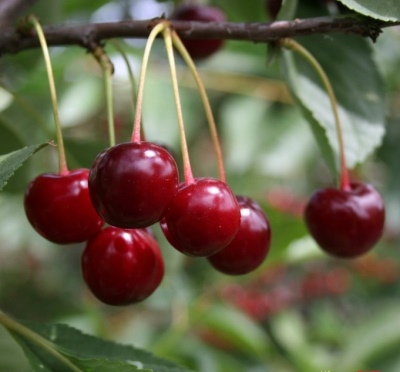
- Authors: X.K. Enikeev (All-Russian Institute of Selection and Technology of Horticulture and Nursery)
- Year of approval: 1959
- Barrel type: wood
- Growth type: medium-sized
- Crown: wide-round, spherical, thick
- Leaves: medium, thin, matte, green, obovate
- Flowering and fruiting type: on a one-year increment
- Fruit size: above the average
- Fruit shape: rounded
- Fruit color: dark red
Cherry has received great recognition for its dietary properties. Cherry Griot Moskovsky is one of the old-timer varieties, which is not inferior in popularity to newer hybrids. The plant has a wide cultivation area due to its unpretentious cultivation, good yield and delicious taste.
Breeding history
The specimen was bred in 1959 by the outstanding biologist Kh. K. Enikeev. The scientist sought to create a cherry variety that is resistant to severe temperature fluctuations and has a high yield. As a result of cloning the variety Griot Ostheimsky, Griot Moskovsky was obtained, which absorbed most of the positive characteristics of the parental variety. At first, the plant was planted only in the Moscow region. Over time, the culture began to be planted in other regions.
Description of the variety
The cherry tree reaches a height of 2.5 m. The highly leafy and dense crown resembles a ball that can be shaped. Thin and drooping shoots give the tree an attractive appearance that also has decorative functions. Leaves of medium size are inversely ovoid. Their color is saturated bright green. Inflorescences are formed on the shoots of the first year of growth.
Fruit characteristics
The dark red, almost black fruits are round and regular in shape and medium in size. The average weight of one cherry reaches 3.5 g. If there are few fruits on the tree, they can have a weight of 5 g. The skin is thin and tender, on which subcutaneous points are barely visible.
The bone is separated from the pulp well. When picking ripe fruits, it is recommended to leave them with a stalk, as the separation is wet. Ripe cherries are not prone to crumbling or baking in the sun.
Taste qualities
The juicy pulp has a medium density consistency. The color is dark red, close to black. The taste of the variety is pleasant, sweet and sour, with a rich cherry aroma. The purpose is technical. Most often used in the preparation of preserves, jams, compotes, fruit drinks and others.
Ripening and fruiting
Actively begins to bear fruit for 3-4 years of planting. The harvest is poor for the first few years. Refers to medium early varieties. Cherry ripens in mid-July. Long-term fruiting - 1-1.5 months.

Yield
Yield indicators are high. On average, you can collect about 9 kg of fruits from one tree or 6-8 t / ha. Due to the fact that the berries are juicy, they must be transported with great care.
Self-fertility and the need for pollinators
To obtain a harvest, it is necessary to plant pollinating plants nearby. Cherries Vladimirskaya, Shubinka, Orlovskaya early, Flask pink are well suited for this purpose. The main thing is to pick up seedlings of the early fruiting period.
Landing
In order for the variety to begin bearing fruit earlier, the tree must be properly planted. The optimal time for planting is mid-April. There is no need to delay the timing, this negatively affects the survival rate.
The place is chosen as illuminated as possible and protected from cold winds. It is best to plant on the south side along the fence. Prefers to grow on fertile soils enriched with humus. The tree categorically does not tolerate waterlogged soil.
Before proceeding with planting, the site is prepared in advance. The earth is dug up, weeds are removed. It is better to plant trees in places where no fruit varieties have previously grown. So bacteria and fungi that can infect young seedlings, leading to their death, can persist in the soil.
The planting hole is dug several weeks before planting. It should be 2 times the size of the root system. A drainage layer, humus, wood ash, sand, phosphorus-potassium fertilizer are placed in the hole. The day before planting, the seedling is soaked in a stimulating solution.
The roots are carefully straightened, the root collar is placed 3 cm above the ground level. The soil is rammed, watered abundantly and mulched with sawdust.


Growing and care
Competent care consists in regular irrigation, additional nutrition, and pruning. In regions with a temperate climate, watering is carried out as needed. In areas with dry summers, trees are watered several times a month.
Watering is especially increased during the period of active flowering and the formation of ovaries. Due to a lack of moisture, the plant will save energy and shed most of the pollinated flowers, which significantly reduces the amount of harvest.
Fertilizers are applied several times a year. In the spring with budding - ammonium nitrate. During flowering, the culture requires a comprehensive nutrition. In the fall, after the harvest is completed, the soil is enriched with potassium and phosphorus.
Sanitary pruning is carried out in spring and autumn. Remove dry, damaged branches with signs of diseases. Shoots are shortened by 1/3 of the length.


































































